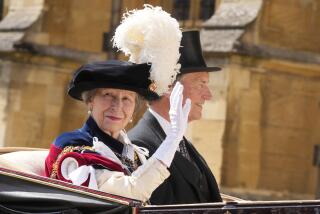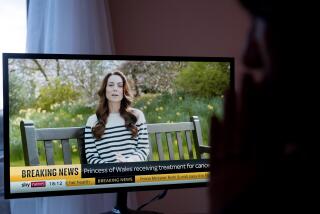Princess by Profession : Alexandra, Who Will Visit Orange County This Week, Is One of Britain’s Most Popular and Accessible Royals
- Share via
When she was a child, she liked to turn cartwheels and be called Sandra, and her ambition was to be a circus bareback rider.
She did become an accomplished horsewoman, but these days you don’t call her anything but “your Royal Highness.” Because Alexandra Helen Olga Christabel, Her Royal Highness Princess Alexandra, Hon. Lady Ogilvy, GCVO, has a richer royal pedigree than the Queen of England.
When Princess Alexandra arrives in Southern California this week to lend the British Royal Family’s presence to the Festival of Britain in Orange County, residents will get a look at not only the Queen’s first--and favorite--first cousin, but a descendant of King George V, King Edward VII, Queen Victoria, King George I of Greece, King Christian IX of Denmark and Czar Alexander II of Russia.
Though she is unknown to most Americans, Princess Alexandra is considered in Britain to be one of the most popular and accessible of the royals. She is just outside the orbit of the queen’s immediate family, but throughout her adult life she has taken on the role of what has come to be known as “professional princess,” representing Britain and the Royal Family at official engagements at home and abroad.
She wears the royal mantle lightly, however.
She is “easily one of the most popular of the royals, a woman of unstuffy charm and classic beauty, regal in presence but highly accessible,” author Ralph G. Martin wrote in his book “Charles and Diana.”
“When she was Diana’s age,” Martin wrote, “she was also known as a marvelous dancer, a gay conversationalist who loved to laugh, adored children, had a craving for sweets and was a ballet addict. Her favorite jazz piece was ‘Ain’t Misbehavin’.’ ”
However, in her professional role, “she’s got an enormous interest in whatever she’s doing,” said Sir Eldon Griffiths, a member of Parliament who lives part time in Orange County, lectures at UC Irvine and is the president of the county office of the World Affairs Council. “That’s the main thing that comes across. She does her homework and she’s very well briefed. She, in fact, goes at it very hard.”
Alexandra’s Festival of Britain visit will be the first time she has traveled to the county, but her brother, the Duke of Kent, and his wife were made honorary citizens during a 1985 visit to dedicate a Laguna Hills housing project.
The princess visited Los Angeles in 1971 in a promotion of British men’s wear and will return there briefly Oct. 15 and 16 briefly after her Orange County visit. Among other things, she will meet with Mayor Tom Bradley, visit Union Avenue Elementary School and observe a program for mothers of children born with a crack addiction at County Harbor/UCLA Hospital.
Mona Mitchell, the princess’ private secretary, said from London that Alexandra was “delighted” by her last visit to Southern California and “thoroughly enjoys travel,” although her schedule while on tour is always tightly controlled.
That sort of schedule has become meat and potatoes for most members of the Royal Family, said John Houlton, a British vice consul based in Los Angeles.
“They take their profession quite seriously,” he said. “We think the princess in a sense serves in an ambassadorial role. She’s a figurehead that people are interested in meeting.”
And it is interesting that in a country of people whose ancestors absolutely hated King George III, modern British royals are often received with the sort of adulation usually reserved for rock stars.
“In California,” Griffiths said, “royalty is a rarity, and its scarcity value gives it a much higher profile. There’s a curiosity that is much more acute here than in Britain.”
Mere curiosity, however, does not fully explain the liquid looks that members of the British Royal family see turned on them when they come here.
“We find it intriguing too, I have to say, that people in the U.S.--and in France too, which is also a republic--are so intrigued,” Houlton said. “I think that part of it is that the Royal Family are very much a national symbol of something that has endured for centuries.
“It has an air of majesty and romance to it. They’re a symbol of permanence in a rather impermanent world these days. I think that’s appealing even to countries that have no wish to have a monarchy of their own.”
Princess Alexandra has felt the glare of celebrity almost all her life.
Born on Christmas Day, 1936 (her fourth name commemorates her birthday), Alexandra is one of three children, and the only daughter, of Prince George and Princess Marina, Duke and Duchess of Kent. Her birth, said her grandmother, Queen Mary, was “the only nice thing to have happened this year”--the year of the abdication of Edward VIII.
She can trace her paternal lineage to Queen Victoria and, on her mother’s side, to Czar Alexander II of Russia (Queen Elizabeth is descended from royalty only on her father’s side).
Alexandra’s father, the son of King George V and Queen Mary, died in 1942 in a plane crash on his way to tour Royal Air Force bases in Iceland during World War II. The princess was raised at Coppins, her family’s country home in the Buckinghamshire village of Iver, by her mother, who was a daughter of Prince Nicholas of Greece and his wife, the former Grand Duchess Helen of Russia.
Although Alexandra’s mother was known as one of the most stylish and glamorous royals of her day, she enrolled her daughter as a student at Heathfield, an exclusive English girls’ boarding school--making Alexandra the first British princess to attend a regular school.
She continued her formal education in the winter of 1953-54, when she attended a finishing school in Paris. When she returned to England, she took a nursing course at the Great Ormond Street Hospital for Sick Children in London, where she was known simply as Nurse Kent.
By the late 1950s, Alexandra had begun to take on more official royal duties, but she had also come to be known as an eligible young princess and began to be seen more in London social circles.
Confrey Phillips, a English-born pianist who performs regularly at the Westin South Coast Plaza in Costa Mesa and once played in London hotels and nightclubs, remembered that during that time Alexandra was “a very likable lady. At that time she was first sort of stepping out. She liked to be with friends and have a nice social evening somewhere privately.
“When I had my nightclub in Mayfair (The Colony on Berkeley Square) she’d come along with her friends and a couple of times with her husband-to-be, although that hadn’t been announced at the time. She liked dancing and loved music.”
She apparently loved Phillips’ music, because Phillips said he and his trio were hired to play at Buckingham Palace for the princess’ 21st birthday.
“There were about 200 people there,” Phillips said, “and it was a great success, a great party. There was continuous dancing.”
The dancing kept up, Phillips said, even when his band took a break. A group of Princess Alexandra’s friends who were amateur musicians acted as a relief band.
“She’s not at all aloof,” he said. “She’s very relaxed and always has a lovely smile and a wonderful soft disposition about her. She’s not wet and frumpish, like some of these aristocrats can be. She’s the least forbidding person you could meet.”
During the time she knew Phillips, Alexandra also became acquainted with a young commoner named Angus Ogilvy. Born in 1928, Ogilvy was the younger son of the Earl of Airlie and grandson of Mabell, Countess of Airlie, who was a close friend and lady-in-waiting to Alexandra’s grandmother, Queen Mary. After an eight-year friendship, the princess and Ogilvy were married in Westminster Abbey on April 24, 1963.
Ogilvy, by his choice, was not catapulted into the aristocratic stratosphere by his marriage. When the Queen offered him an earldom (a common practice when a princess marries someone of lesser rank), Ogilvy refused.
“I don’t see why I should get a peerage just because I married a princess,” he said at the time.
However, the Queen did confer a knighthood on Ogilvy in 1989, making him a Knight Commander in the Royal Victorian Order.
A businessman who is on the boards of directors of several British companies, Ogilvy accompanies the princess on many of her trips abroad (he will come with her to Orange County) and is properly addressed as Sir Angus.
The Ogilvys have two children, James Robert Bruce, born in 1964 and married to Julia Rawlinson, and Marina Victoria Alexandra, born in 1966 and married to Paul Mowatt. Neither are titled and are not considered to be royal.
Ogilvy once underscored the somewhat hybrid nature of his immediate family by referring to its members as “mini-royals.”
Alexandra’s many tours, duties and appearances entitle her to receive money from the Civil List, which is an allowance given to members of the Royal Family by Parliament to help pay for staff and expenses.
“Much of the public wrongly assumes that all royals are rich,” Martin wrote. “Princess Alexandra . . . had no money of her own. Neither did Angus Ogilvy, since his older brother inherited both the family title and the family fortune.”
Griffiths said he believes that the Princess was the first member of the Royal Family to drive herself routinely and to ride the Underground rather than be chauffeured. (In fact, in 1962, she crashed her Austin Mini into a truck on London’s Kensington High Street. She later admitted that she had been driving a bit too fast.)
Alexandra does have an extensive collection of jewels that have come to her through her royal relatives. But the woman wearing the gems, so firmly rooted in royal tradition, apparently has little use for any pretense that might be attached to them.
In the midst of the sometimes-stifling pomp associated with royal appearances, she has shown a sense of good-humored proportion.
“Don’t forget,” she said of the Royal Family in the 1960s, “that nowadays we have to compete with Elizabeth Taylor and the Beatles.”
Times staff writer Patt Morrison contributed to this story. Patrick Mott is a Costa Mesa-based free-lance writer.
More to Read
Sign up for The Wild
We’ll help you find the best places to hike, bike and run, as well as the perfect silent spots for meditation and yoga.
You may occasionally receive promotional content from the Los Angeles Times.





